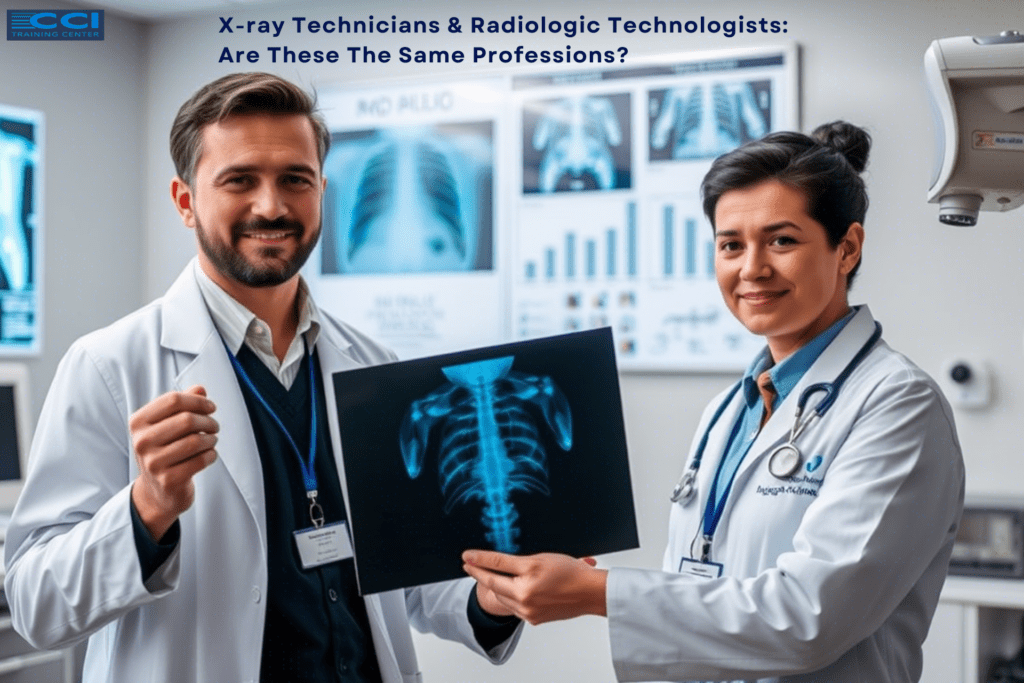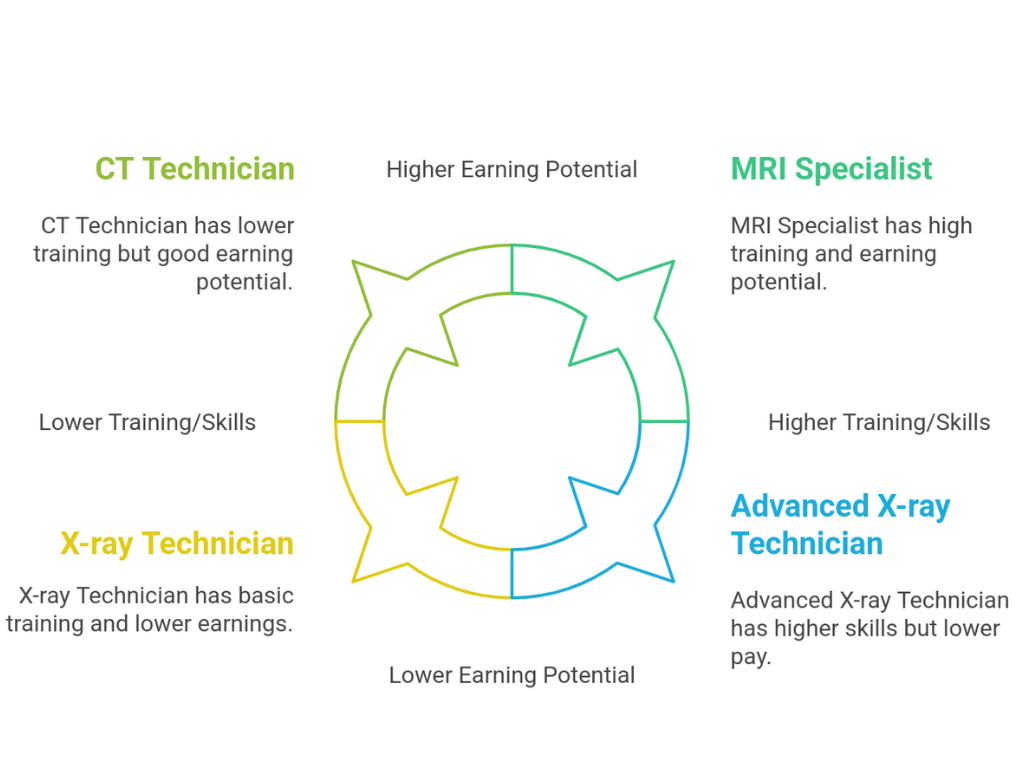X-ray Technicians & Radiologic Technologists: Same Profession or Different?

“The stethoscope listens to the body, but imaging shows its truth.” — Medical Proverb
Many medical professionals consider Medical Imaging the backbone of modern healthcare. Healthcare professionals, such as X-ray technicians and Radiologic technologists, are essential in diagnostics.
These professions offer exceptional choices for a healthy medical career with an exponential growth of 6%, and anyone interested in the healthcare sector, including recently graduated students, should definitely consider them.
One common question arises: Are these two professions the same, or different?
| Both professions involve medical imaging, but there are differences in the scope of practice, training, and job roles. |
The objective of the blog is to break down the similarities, differences, duties, responsibilities, training, salaries, and career paths so that you can learn in depth to make the correct career choice based on your needs and preferences.
X-Ray Technicians: An Overview
X-ray Technicians are limited-scope medical technicians whose primary role includes performing basic X-ray imaging, such as:
- Skeletal X-rays
- Chest X-rays
Here is the list of basic requirements:
- Education: Generally requires a certificate or diploma program of 1 to 2 years.
- Certifications: Some states require licensure for practice, but in some states, there is no strict mandate for a certificate to practice.
- Work Settings: These technicians are required in clinics, urgent care centers, mobile imaging units, chiropractic offices, and other similar settings.
- Limitations: Most of the tasks are restricted to X-rays only, with no advanced medical imaging (MRI or CT)
Radiologic Technologists (Radiographers): An Overview
Radiologic technologists, often referred to as radiographers, are involved in a wider range of imaging procedures. These typically include:
- X-rays
- CT scans
- MRIs
- Fluoroscopy
- Mammography
Here is the list of basic requirements:
- Education: Generally requires an associate or bachelor’s degree in Radiologic Technology (2-4 years).
- Certification: Most states in the United States require passing the ARRT (American Registry of Radiologic Technologists) exam.
- Work Settings: These medical professionals are required in hospitals, diagnostic imaging centers, trauma centers & care facilities, and specialized radiology departments.
- Opportunities: They specialize in MRI, CT, radiation therapy, and nuclear medicine.
Comparison Of Job Duties
| S.No | X-ray Technicians | Radiologic Technologists |
01. | Operates X-ray machines for basic imaging | Performs X-rays + advanced modalities (CT, MRI, fluoroscopy) |
02. | Positions patients for optimal imaging | Adjusts equipment settings for complex scans |
03. | Follows radiation safety protocols | Assists radiologists in interventional procedures |
04. | Works under a radiologist or physician | May supervise X-ray technicians in some settings |
05. | Limited to diagnostic X-rays | Can specialize in cardiac imaging, mammography, etc. |
X-ray Technicians’ Salary Vs Radiologic Technologists’ Salary
Here is a quick comparison of salaries between the two professions:
As per the data by the U.S BLS (United States Bureau Of Labor Statistics) –
X-ray Technicians (Limited Scope): ~45,000−60,000 per year (varies by state and experience).
Radiologic Technologists: ~60,000−85,000 annually (higher in specialized roles like MRI/CT).
Two essential factors are responsible for the wages of both professions:
- Experience level
- Job Location
It’s due to:
Career Growth Opportunities: Which Course Is Right For You?
The career choice you make depends on your needs and preferences. If you want to quickly start your career, choosing to become an X-ray technician is a better option due to the shorter duration of X-ray technician programs compared to Radiologic technologist programs.
If you are trying to get into a radiology or imaging career path, opting for certificate-based programs such as radiology technician (limited-scope) is a step in the right direction.
These fast-track programs prepare for the relevant ARRT exam and provide assistance in preparing for and obtaining the relevant state license, allowing students to start work quickly. Once the program is completed, there is always an opportunity for further education and career advancement, but the limited radiology job training program is a great start.
X-ray technicians can advance their careers by upgrading their skills with additional certifications, such as ARRT post-primary certifications.
If you are interested in more advanced tech and career options, then you should definitely choose Radiology technologists as your career choice. It presents opportunities such as:
- MRI Technologist
- CT Technologist
- Mammography
- Interventional Radiology (IR) Technologist
Conclusion
The pathway in the medical field will always be a positive step in the service of humanity. Whether you decide to become an X-ray technician or a Radiologic technologist, both career choices will be rewarding in their own ways.
Remember the wise words:
“In radiology, we don’t just take pictures; we save lives one scan at a time.”
Both professions have high potential for growth in the next decade in the evolving field of medical imaging.
Program Offered
- Pharmacy Technician Training
- Online Medical Assistant
- Medical Billing and Coding Specialist Program
- Cloud Computing Technician Training
- Computer Network Technician
- Business and Accounting
- Radiology Technician Training
- Medical Assistant Program
- Computer Support Technician
- Cybersecurity Program
- Virtual Assistant Training

This article is written by
Share this article
Program Offered
- Pharmacy Technician Training
- Online Medical Assistant
- Medical Billing and Coding Specialist Program
- Cloud Computing Technician Training
- Computer Network Technician
- Business and Accounting
- Radiology Technician Training
- Medical Assistant Program
- Computer Support Technician
- Cybersecurity Program
- Virtual Assistant Training

This article is written by
Share this article
Related Articles







CCI Training Center Proudly Completes
41 Years in Career Training Services











